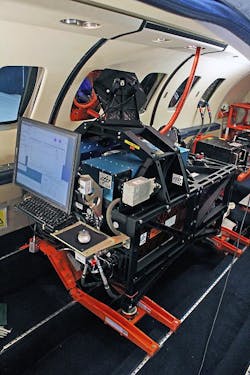DELICAT LIDAR system alerts pilots to air turbulence ahead
Bonn, Germany--Researchers at the German Aerospace Center DLR Institute of Atmospheric Physics have developed a light detection and ranging (LIDAR) instrument that can detect air turbulence before it is encountered by an aircraft. The LIDAR system—installed onboard an aircraft—emits short-wave ultraviolet (UV) laser radiation along the direction of flight. The density of the air is determined from the backscatter value measured for the air molecules oxygen and nitrogen and fluctuations in this density provide information about the clear-air turbulence ahead.
Clear-air turbulence (CAT) occurs independently of cloud cover, is invisible, and cannot be accurately predicted. For both passengers and crew, strong turbulence can mean an increased risk of falls and accidents. Recent results in atmospheric research indicate that such turbulence will occur more frequently due to climate change and will become even more of a problem for aircraft. The LIDAR method to predict CAT was developed under a European joint project called DELICAT (http://www.delicat.inoe.ro/) (Demonstration of LIDAR based Clear Air Turbulence detection). The new technology is currently being tested by the German Aerospace Center (Deutsches Zentrum für Luft- und Raumfahrt; DLR) and the project partners. The current measurement flight campaign will take place until the end of August. The flight route starts in Amsterdam and continues throughout Europe.
Wind shear often occurs along the jet stream. This involves extended layers of air that move against each other horizontally at different speeds. Particularly strong wind shear can create waves that ultimately break, like waves on water. When a wave breaks, it either causes vortices in the air, or turbulence—specifically CAT. When an aircraft encounters this turbulence, it alters the angle of the airflow over the wings; this leads to the familiar changes in lift. CAT has long been an unavoidable phenomenon in aviation, as these swirling air masses in the clear sky are neither visible to the eye nor measurable with sensors.
The project DELICAT test flights currently taking place are being used to demonstrate the measurement process and the functioning of the new technology. The PH-LAB research aircraft, a modified Cessna Citation operated by Dutch partner 'National Aerospace Laboratory' (Nationaal Lucht- en Ruimtevaartlaboratorium; NLR), is being used for this. The DLR UV-LIDAR system has been installed for the laser measurements. The long-term goal is to develop an integrated detection system for avoiding air turbulence. In future, pilots might then be able to put out a message in the aircraft cabin asking passengers to return to their seats and fasten their seat belts, or even fly around the affected region.DELICAT is a joint project sponsored by the European Union. It was launched in 2009 and will end in March 2014. In total 12 partners from seven EU countries are participating in the joint project: project coordinator THALES, the German Aerospace Center (DLR), Centre National de la Recherche Scientifique (CNRS), Hovemere, Météo France, Nationaal Lucht- en Ruimtevaartlaboratorium (NLR), Office National d'Etudes et de Recherches Aérospatiales (ONERA, the French Aerospace Lab), National Institute of Research and Development in Optoelectronics (INOE), A. M. Obukhov Institute of Atmospheric Physics of the Russian Academy of Sciences, Laser Diagnostic Instruments, Interdisciplinary Centre for Mathematical and Computational Modelling/Warsaw University, and EADS Deutschland GmbH.
SOURCE: DLR; http://www.dlr.de/dlr/en/desktopdefault.aspx/tabid-10081/151_read-7615/year-all/#gallery/11638
About the Author

Gail Overton
Senior Editor (2004-2020)
Gail has more than 30 years of engineering, marketing, product management, and editorial experience in the photonics and optical communications industry. Before joining the staff at Laser Focus World in 2004, she held many product management and product marketing roles in the fiber-optics industry, most notably at Hughes (El Segundo, CA), GTE Labs (Waltham, MA), Corning (Corning, NY), Photon Kinetics (Beaverton, OR), and Newport Corporation (Irvine, CA). During her marketing career, Gail published articles in WDM Solutions and Sensors magazine and traveled internationally to conduct product and sales training. Gail received her BS degree in physics, with an emphasis in optics, from San Diego State University in San Diego, CA in May 1986.

